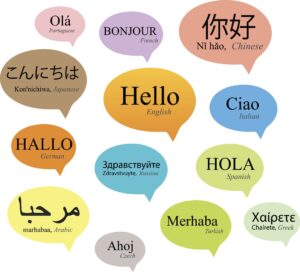In recent years, technology has revolutionized the way we communicate with one another. One of the most exciting advances in this field is the use of artificial intelligence (AI) to facilitate language translation. AI translators are becoming increasingly popular as they offer improved accuracy and convenience compared to traditional methods.
AI translators have many advantages over traditional human-based translation services. For instance, they are able to provide accurate translations faster and for a fraction of the cost. Additionally, as AI translators are powered by sophisticated algorithms, they can also be used to translate multiple languages at once.
AI translators use a combination of machine learning (ML) and natural language processing (NLP) techniques to understand the context of sentences in different languages and generate accurate translations. ML algorithms allow AI translators to “learn” from past translations and refine their accuracy over time.
Moreover, AI translation services are becoming increasingly accessible as more companies offer them. Google Translate, for example, is one of the most popular free AI translators available today. It offers instant translations in over 100 languages and provides audio support for some languages as well.
AI Translators

AI Translators
Language barriers have been a major hindrance to global communication and understanding for centuries. However, with the advent of Artificial Intelligence (AI) translators, language translation has become more accessible and accurate than ever before. In this article, we will explore how AI translators work, their benefits, and their impact on language translation.
What is an AI Translator?
An AI translator is a type of machine translation that uses algorithms and natural language processing (NLP) to translate text or speech from one language to another. Unlike traditional translation methods that rely on human translators, AI translators use statistical models and machine learning techniques to identify patterns and translate language.
AI translators can be used for various applications, including online communication, customer support, e-commerce, education, and travel. They can also be integrated into software, websites, and mobile apps, making it easier for businesses and individuals to communicate with people from different cultures and languages.
How AI Translators Work
AI translators use complex algorithms and NLP techniques to analyze the source text and generate a translation that is as accurate as possible. The process involves several steps, including:
- Text Analysis: The AI translator analyzes the source text and identifies its grammatical structure, syntax, and vocabulary.
- Translation: The AI translator uses statistical models and machine learning algorithms to generate a translation based on the analyzed text.
- Post-Editing: The AI translator uses post-editing techniques to refine the translation and ensure that it is accurate and grammatically correct.
- Quality Assessment: The AI translator uses quality assessment metrics to evaluate the accuracy and quality of the translation.
Benefits of AI Translators
AI translators offer several benefits over traditional translation methods, including:
- Faster Translation: AI translators can translate large volumes of text or speech in a fraction of the time it would take a human translator.
- Consistent Translation: AI translators produce consistent translations that are free from errors, omissions, and inconsistencies.
- Cost-Effective: AI translators are more cost-effective than human translators, making language translation more accessible to businesses and individuals.
- Customizable: AI translators can be customized to meet the specific needs and requirements of businesses and individuals.
- Improved Accuracy: AI translators use advanced algorithms and NLP techniques to generate accurate translations that are as close to the source text as possible.
Impact of AI Translators on Language Translation
AI translators have revolutionized language translation by making it more accessible, accurate, and cost-effective. They have also helped to bridge language barriers and promote global communication and understanding.
However, AI translators are not without their limitations. They may struggle with idiomatic expressions, cultural nuances, and context-dependent language. They may also struggle with translating technical or specialized language that requires domain-specific knowledge.
Examples of AI Translators
There are several AI translators available in the market today, each with its own strengths and weaknesses. Here are some examples of popular AI translators:
- Google Translate – Google Translate is a free online translation tool that uses AI to translate text, speech, and images from one language to another. It supports over 100 languages and is available on web browsers, mobile devices, and as an API for developers.
- Microsoft Translator – Microsoft Translator is another popular AI translator that supports over 60 languages. It can be used on web browsers, mobile devices, and as an API for developers. It also offers features such as real-time translation, text-to-speech, and speech-to-text.
- DeepL – DeepL is an AI translator that uses neural networks to generate translations that are more accurate and natural-sounding than traditional statistical machine translation. It supports several European languages and is available on web browsers and as an API for developers.
- SDL Trados – SDL Trados is a translation software that uses AI to assist human translators in translating documents. It offers features such as translation memory, machine translation, and terminology management to improve the speed and accuracy of translation.
- SYSTRAN – SYSTRAN is an AI translator that uses hybrid machine translation to generate accurate translations. It supports over 140 languages and is available as a desktop software, cloud-based service, and API for developers.
These are just a few examples of the many AI translators available in the market today. Businesses and individuals can choose the AI translator that best meets their needs and requirements based on factors such as language support, features, and cost.
Wrapping Up
AI translators are transforming the field of language translation by providing fast, consistent, and accurate translations that are more accessible and cost-effective than traditional translation methods. While they are not without their limitations, they offer significant benefits to businesses and individuals looking to communicate with people from different cultures and languages. With continued advancements in AI technology, the future of language translation looks bright.
Leave a Reply